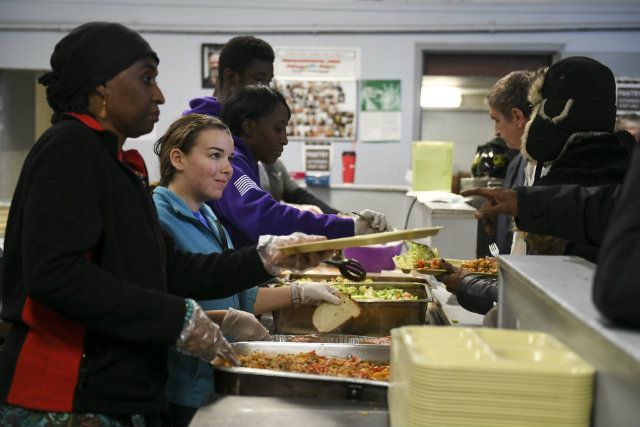How important is community involvement at your business?
The answer? Very. Research indicates that companies who have functionally and emotionally engaged employees outperform companies who don’t by over 200%.
If you’re not sure how your company is doing in this regard, it may be time to start exploring volunteerism and charity work. Taking on a philanthropic attitude can transform a workplace culture and benefit a company (and the people who work for it) in more ways than one.
 Charitable work isn’t reserved only for the Fortune 500s or mom-and-pop establishments: businesses of all sizes can benefit. Whether your business is small or large, local or national, fledgling or well-established, you’d be hard-pressed to find a reason not to get your entire team more charitably involved.
Charitable work isn’t reserved only for the Fortune 500s or mom-and-pop establishments: businesses of all sizes can benefit. Whether your business is small or large, local or national, fledgling or well-established, you’d be hard-pressed to find a reason not to get your entire team more charitably involved.
Here’s why — and then how to do it.
5 Benefits of Volunteerism and Charity Work for Businesses
1. Positive community impact.
Charitable work is on the rise overall. According to Giving USA, Americans (including individuals, estates, foundations, and private corporations) gave a whopping $390.05 billion to US charities in 2016 (notwithstanding thousands of volunteer hours), making it one of our nation’s most charitable years ever.
Involving your company in such a growing cause can directly benefit the community where your business is located (especially when you consider that when it comes to volunteering there’s usually strength in numbers). And by driving healthier, more economically sound communities through charitable work, it’s reasonable to suggest that local companies (and their potential customers) stand to benefit.
2. Potential for financial benefits for employer and employee.
Most charitable donations are tax-deductible for the individual, which can save hundreds of dollar come tax season. Likewise, if your company chooses to offer matching donations, you can deduct these from your own business tax bill, as well (in addition to simply donating money without using an employee-match model).
3. Improved workplace environment and culture.
According to the Bureau of Labor Statistics, employed Americans are more likely to spend time volunteering than those who are unemployed. Good news for you as a business owner, since volunteerism has been shown to improve several aspects of workplace environment, including increased productivity, gratitude, and employee satisfaction.
In surveys, employees at companies like Patagonia and Salesforce — both recognized by Fortune to be among the top US philanthropic corporations — have also noted the great sense of pride in the businesses they work for thanks to their employer-supported volunteer work. What employer wouldn’t want a team of people who stand behind their company’s mission and values?
4. Better health for employees.
As referenced by the National Corporation for National & Community Service, research shows that volunteering is associated with a reduced mortality risk as well as reduced risk of certain health problems, including heart disease and depression. For your employees, this can potentially translate to fewer sick days, less burnout, and improved focus in the workplace. We’ll argue these benefits are even more likely if volunteerism isn’t just appreciated by but part of the culture of your company.
5. Increased brand recognition and reputation.
At its most basic, volunteer work in your community gets your company’s name out there. Sure, call it a marketing opportunity, but there’s certainly no shame in that. This type of brand recognition allows your employees to interact with current and prospective customers with pride, and often with customers they wouldn’t necessarily be able to reach otherwise (think: volunteering in local schools, hospitals, etc.).
6 Tips for Getting Started with Charity Work
Don’t have a great soup kitchen near your company’s office? Not to worry: there are plenty of other ways to get your employees involved in this beneficial extracurricular activity.
1. Consider Workplace Giving and Other Incentives
As defined by America’s Charities, workplace giving is generally defined as “annual, employer-sponsored programs that offer employees the opportunity to make a charitable contribution through payroll deduction.” If relevant, consider speaking with your HR rep or accounting team about making this option available for your staff. Additional incentives that many companies choose to offer include PTO for volunteering, reimbursements for associated costs, and employee matching programs.
 2. Check Available Resources
2. Check Available Resources
Volunteer referral websites are handy places to connect with local, national, and global charitable causes (including online work, which may be more practical for virtual companies or a simple way to integrate this new philosophy into any company). Try these:
Remember, too, that you can always check with your local Chamber of Commerce or community service program. Every town has its unique needs and opportunities for small and large companies to get involved.
3. Do Your Research
If you’re attempting to create a company-wide engagement in a specific charity or cause, be sure to practice due diligence and do your research. Being able to tell your team where and how your charity of choice allocates its resources shows your employees you take their time and money seriously. (A resource like the Charity Checklist from the Federal Trade Commission is a helpful tool for this reason.)
As an extra incentive, see if your selected organization offers any sort of specialized training or certifications. Presenting a curriculum vitae building opportunity provides even more value to your employees who may otherwise pass up an opportunity to get involved.
Such certifications or training, of course, would be in addition to the professional benefit that volunteerism in and of itself offers to employees. Research suggests hiring teams frequently place an equal weight on a potential hire’s volunteer experience as they do for related paid work experience. Even if we can assume your goal as a business owner is to retain talent vested in the mission of your company, it’s still a respectable nod to your employees that you’re willing to help them appear more valuable in the face of competitive hiring markets.
4. Seek Employee Feedback
Ask your team:
- What do you care about?
- What’s important to you?
- Where and how are you already making a difference?
You may be surprised to find that many of your employees are already involved in some sort of charity work or volunteerism. Often this is because a given cause has had a personal impact on that individual’s life or the life of one of their loved ones.
Create opportunities for members of your staff to let you know about the causes they care about, and consider asking how the company can contribute to their activism or charity work. This personal touch is often what inspires an entire group of people to stand behind a single cause, and helps drive better employee engagement.
5. Delegate Volunteerism and Charitable Leadership Among Staff
Who in your business would be a great champion of your company’s charitable involvement? Can you identify team members who could spearhead a community outreach or volunteer program?
Hint: It doesn’t necessarily have to be you.
Companies like NuStar Energy implement volunteer councils that help streamline the decision-making process of choosing organizations, organizing company volunteers, and and arranging research and follow-through with charities. Not only can this improve efficiency and efficacy of your company’s philanthropic involvement (and reduce the responsibility on you), but it can help foster a sense of pride and leadership at multiple levels of your organization, as well.
6. Remove As Many Barriers to Volunteerism as Possible
Can you contact your local hospital or Red Cross organization to host a blood drive on your company campus? Can you host a fundraising event in your office during normal business hours? Can you sponsor company-wide Volunteer Days to garner more interest and engagement? Is there a children’s program that could use help? What about researching and sharing online volunteer opportunities with your team?
How Will You Get Started?
These and other questions are worth asking, and the entire concept of volunteerism and charity is worth considering no matter the size and scope of your business. Anything you can do to make it easier for your employees to get interested and involved in volunteering is a boon for you, your team, and your community.









